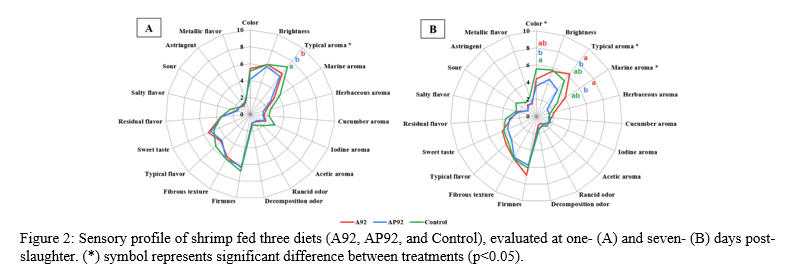EFFECTS OF HIGH-LEVEL FISHMEAL REPLACEMENT ON GROWTH, GUT AND BIOFLOC MICROBIOTA, AND POST-HARVEST QUALITY EVALUATION IN Penaeus vannamei UNDER BFT
Introduction
Fishmeal (FM) is the main cost driver in shrimp aquaculture, accounting for 50–70% of total production costs. Previous studies have demonstrated that P enaeus vannamei can tolerate partial FM replacement without compromising growth performance. Additionally, biofloc technology (BFT) provides a nutritional supplement and enhances shrimp immunity. This study aimed to evaluate the impact of FM substitution with alternative protein sources in shrimp diets on the microbial composition of biofloc, and to explore potentials interaction with intestinal microbiota, growth performance and product quality.
Material and Methods
Six experimental diets were tested in triplicate, featuring either 92% or 100% replacement of fishmeal (FM) with alternative protein sources of animal origin (A92, A100), plant origin (P92, P100), or a combination of both (AP92, AP100). All diets were isoproteic (38% protein) and isolipidic (10% fat). Shrimp were cultured in 1 m³ tanks at 350 individuals/m³ from 2.5 g to 8 g average weight. Growth was monitored biweekly. Biofloc and shrimp gut microbiota were characterized by full-length 16S rRNA gene sequencing (PacBio Sequel II), and amplicon sequence variants were analyzed using QIIME2 and CLR transformation. Sensory quality of shrimp from selected diets was evaluated at 1 and 7 days post-slaughter following ISO standards.
Results and discussion
Water quality parameters remained within optimal ranges for shrimp culture. Growth performance confirmed that up to 92% FM replacement with animal (A92) and mix of animal/plant protein sources (AP92) is feasible without negative effects. These findings exceed the FM substitution levels reported in previous studies using plant- or animal-based alternatives, or their combination (Aya et al., 2015, Cheng et al., 2002 , Hulefeld et al. 2018).
High-quality 16S rRNA gene sequencing data were obtained across all treatments, with a minimum of 81% non-chimeric reads per sample. The most abundant phyla in biofloc bacterial community were Proteobacteria , Patescibacteria, and Planctomycetota, which together represented approximately 68% of the total microbial community. At the taxonomic level of order, SBR1031 and Pirellulales were dominant, accounting for 29% of the overall composition . At the family level, the most prevalent taxa were Woesebacteria (14%) and Pirellulaceae (12%; (Figure 1A ). While the presence of Proteobacteria and Planctomycetota is commonly reported in biofloc systems (Tanay et al. 2020, Vinasyiam et al. 2025) , the detection of Patescibacteria, although possible , is often associat ed with methanogenic archaea. This finding may suggest the formation of microenvironments with reduced oxygen availability within the culture system (Kuroda et al. 2024). Furthermore, the presence of Woesebacteria is associated with anoxygenic denitrification (Rajeev et al 2024), and the Pirellulales and Pirellulaceae, taxa are typically found in low-oxygen environments (Dedysh et al. 2020), supports this hypothesis. In contrast, the intestinal microbiota of shrimp was primarily composed of Proteobacteria, Planctomycetota , Chloroflexi, and Actinobacteriota, which together constituted 88% of the microbial community. This profile is consistent with previously reported profiles in shrimp of similar size classes (Zeng et al. 2017). At both the order and family levels, Pirellulales and the corresponding Pirellulaceae were the most abundant taxa, each representing approximately 18% of the total microbiota (Figure 1B) . The composition of the shrimp gut microbiome is known to be strongly influenced by environmental parameters, farming conditions, and the developmental stage of the animals. The consistent dominance of Pirellula at both the order and family levels reflects this influence. Moreover, the occurrence of the main phyla is consistent with previously reported profiles in shrimp of similar size classes (Zeng et al. 2017).
Regarding alpha diversity, analysis revealed a lower microbial diversity in the initial shrimp samples, based on the Simpson and Shannon indices. However, no significant differences were found at the end of the trial between treatments in either biofloc or shrimp samples. In terms of beta diversity, no statistically significant differences were detected among treatments in any samples.
In relation to the sensory profiles, by day 1, a distinctive shrimp aroma was observed to the Control treatment. Meanwhile by day 7, Control shrimp exhibited the highest color scores, while A92 shrimp obtained the highest marine a typical aroma score (Figure 2. A y B ). The melanosis incidence averaged 9% across all treatments initially. However, by day 7, shrimp fed the AP92 diet showed significantly lower melanosis levels (25%) compared to other groups, indicating reduced susceptibility associated with this dietary treatment.
In summary, up to 92% of fishmeal can be replaced with animal or mixed alternative proteins without compromising shrimp growth, water quality, microbiota stability, or sensory quality. Diet composition influenced shrimp-associated microbial communities more than biofloc communities, suggesting host-specific filtering mechanisms. In addition, certain alternative protein diets (AP92) may improve post-harvest quality by reducing melanosis, highlighting the potential of these formulations for sustainable shrimp production.
Acknowledgments
These results are part of the I+D+i Research Project: “Optimizing shrimp feeding and nutrition in biofloc system (BioFlango )” (PID2020-114574RB-C21), and the Research Personnel Training Grant (PRE2021-098367); supported by MCIN/ AEI/10.13039/501100011033/. J. Gómez-Aguilera contract was supported by European Union Next Generation-Plan of Conselleria d’innovació , Universitats , Ciència i Societat Digital of Generalitat Valenciana (INVEST/2022/434).
Bibliography
Huang, Z., Li, X., Wang, L., & Shao, Z. (2016). Changes in the intestinal bacterial community during the growth of white shrimp, L itopenaeus vannamei. Aquaculture Research, 47(6), 1737-1746.
Landsman, A., St-Pierre, B., Rosales-Leija, M., Brown, M., & Gibbons, W. (2019). Impact of aquaculture practices on intestinal bacterial profiles of Pacific whiteleg shrimp Litopenaeus vannamei. Microorganisms, 7(4), 93.
Rajeev, M., Jung, I., Kang, I., & Cho, J. C. (2024). Genome-centric metagenomics provides insights into the core microbial community and functional profiles of biofloc aquaculture. Msystems, 9(10), e00782-24.

